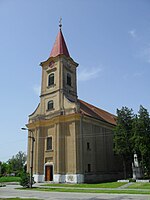The Battle of Hetény-Kurtakeszi-Izsa, fought on 10 September 1849 between a Hungarian troop from the Fortress of Komárom and a Russian detachment of Cossacks, was one of the last battles of the Hungarian War of Independence. The battle followed the Surrender at Világos by General Artúr Görgei, leader of the Hungarian army, on 13 August 1849. After this surrender, one of the last strongholds of Hungarian independence was the fortress of Komárom, which was then surrounded by Austrian and Russian troops. During September 1849, a number of smaller battles and skirmishes were fought between the Hungarian defenders and the Russian-Austrian besieging troops. The Russians and Austrians sought to tighten the blockade around the Hungarian fortress, in order to seize it by direct assault as soon as possible. Meanwhile, the Hungarians attempted to gain intelligence regarding the strength of the besieging troops. On 10 September, General György Klapka, the commander of the fortress, learned that the Russians had smaller units stationed northeast of Komárom. General Klapka sent a detachment to gather information, but unbeknownst to the Hungarians, the Russians had much superior forces, which compelled the Hungarians to retreat. The Russian forces tried to cut off the Hungarian retreat, but the Hungarians managed to repel them. As a result of this encounter, Klapka learned that the enemy forces surrounding Komárom were indeed vastly superior to his own forces. After a two-week armistice, various battles and skirmishes continued between the Hungarian troops and the Russian-Austrian besieging units.








